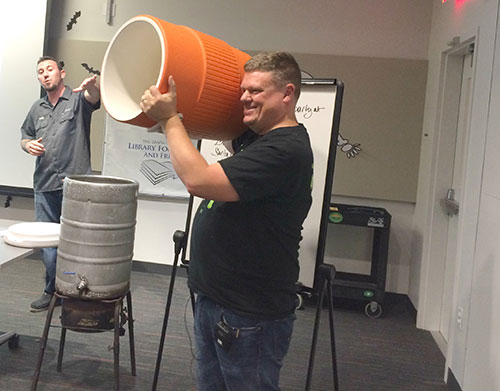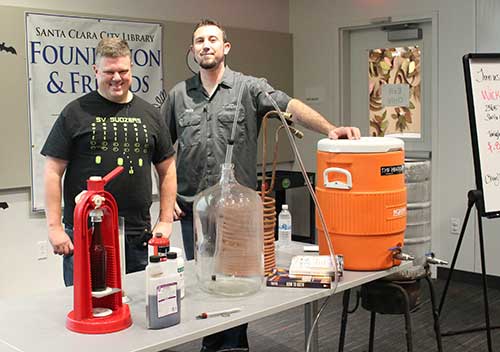

Passed around at Northside Library’s Homebrewing 101 workshop on Tuesday, Oct. 27 were small cups filled with fragrant malted barley and pungent hops, which are flowers of hop vines. Attendees sniffed at these beer ingredients while learning about how they could make beer at home.
“The goal is to teach people you can brew beer in your house,” says Cheryl Lee, Northside Library’s branch manager and program coordinator.
The presenters were Derek Wolfgram, director of the Redwood City Public Library and Vice President of Silicon Valley Sudzers, and Andy Carroll, founder of The Headquarters Homebrew Club in Campbell.
“There are two main families of beer based on the type of yeast that’s used,” says Wolfgram, who has brewed at least 80 batches of beer. “Top-fermenting yeast is what’s used in fermenting ales. They ferment a little warmer at room temperature, much easier for the homebrewer than lagers, which requires refrigeration through the entire process so you’d have to have a little bit more equipment, a little bit more time on your hands.”
On the projector screen, Wolfgram outlined three homebrewing methods: brewing from a machine, extract brewing and all-grain brewing.
“For all-grain brewing, first you do the mash, where you steep the grains in water to extract the sugars,” Wolfgram says. “And then you do the boil and during the boil is when you add the hops. And then after the boil, you chill it down so that it’s the right temperature for adding yeast. The yeast takes one to two weeks to ferment the beer. For extract brewing, you don’t do the mash.”
A brewer of over 125 batches of beer, Carroll brought his homebrewing equipment.
“The basic equipment includes the orange tub which is the mash tun- that’s where all the grain goes in,” Carroll says. “The glass carboy is the fermentation vessel. The boil kettle is a big cooking pot. The red apparatus I brought with the bottle in it is the bottling machine. I also brought the copper coil, which is the immersion chiller. That cools the beer after boiling.”
Carroll also reviewed “The Homebrewer’s Twelve Step Program” where he encouraged brewers to make sure that their equipment is sanitized to avoid problems in the final product. He also thinks attendees should record what they do, because if they brew an excellent beer they will want to recreate the recipe.
Beer production began in ancient Egypt as early as about 10,000 to 4,000 B.C., according to Wolfgram.
“In the [American] colonies there actually was beer production,” he says. “We didn’t have refined ingredients with the malted barley and all the things that exist today. Basically anything that had starches in it could be fermented. Some people found historical recipes that Thomas Jefferson brewed, and tried to recreate them. They’re pretty rough. They’re not anything we would probably recognize as craft beer today.”





